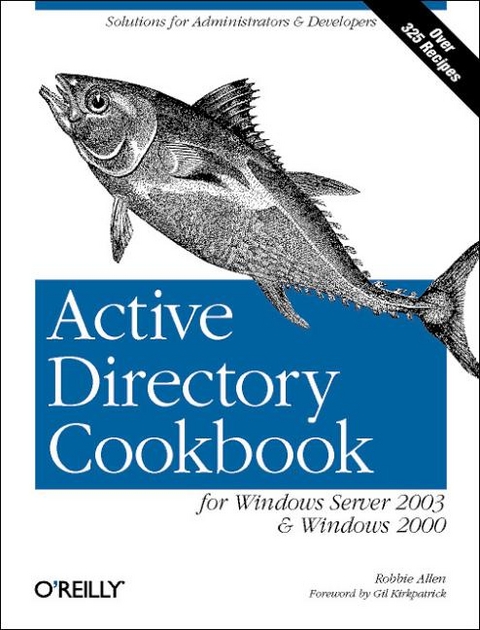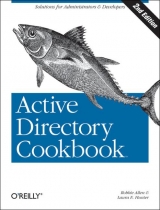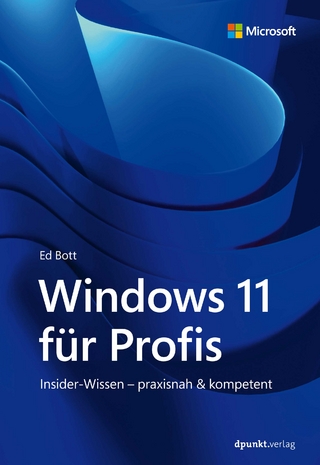
Active Directory Cookbook for Windows Server 2003 and Windows 2000
O'Reilly Media (Verlag)
978-0-596-00464-4 (ISBN)
- Titel ist leider vergriffen;
keine Neuauflage - Artikel merken
Those of you who run networks on Windows 2000 know the benefits of using Active Directory for managing user information and permissions. You also know what a bear it can be. The newer version included with Windows Server 2003 has over 100 new and updated features to simplify deployment, but once it's in place many system administrators still find Active Directory challenging. If you're among those looking for practical hands-on support, help is here with our new Active Directory Cookbook for Windows Server 2003 & Windows 2000, a unique problem-solving guide that offers quick answers for both versions of the directory. The book contains hundreds of step-by-step solutions for both common and uncommon problems that you might encounter with Active Directory on a daily basis--including recipes to deal with the Lightweight Directory Access Protocol (LDAP), multi-master replication, Domain Name System (DNS), Group Policy, the Active Directory Schema, and many other features.
Author Robbie Allen, a Senior Systems Architect at Cisco Systems and co-author of our Active Directory tutorial, based this collection of troubleshooting recipes on his own experience, along with input from Windows administrators throughout the industry. Each recipe includes a discussion to explain how and why the solution works, so you can adapt the problem-solving techniques to similar situations. If your company is considering an upgrade from Windows NT or 2000 to Windows Server 2003, the Active Directory Cookbook for Windows Server 2003 & Windows 2000 will help reduce the time and trouble it takes to configure and deploy Active Directory for your network. This Cookbook is also a perfect companion to Active Directory, the tutorial that experts hail as the best source for understanding Microsoft's network directory service. While Active Directory provides the big picture, Active Directory Cookbook for Windows Server 2003 & Windows 2000 gives you the quick solutions you need to cope with day-to-day dilemmas.
Together, these books supply the knowledge and tools so you can get the most out of Active Directory to manage users, groups, computers, domains, organizational units, and security policies on your network.
Robbie Allen is a Senior Systems Architect in the Advanced Services Technology Group at Cisco Systems. He was instrumental in the deployment and automation of Active Directory, DNS and DHCP at Cisco. Robbie enjoys working on the UNIX and Windows platforms, especially when Perl is installed. He is a firm believer that all system administrators should be proficient in at least one scripting language and most of his writings preach the benefits of automation.
Foreword Preface 1. Getting Started 1.1 Where to Find the Tools 1.2 Getting Familiar with LDIF 1.3 Programming Notes 1.4 Replaceable Text 1.5 Where to Find More Information 2. Forests, Domains, and Trusts 2.1 Creating a Forest 2.2 Removing a Forest 2.3 Creating a Domain 2.4 Removing a Domain 2.5 Removing an Orphaned Domain 2.6 Finding the Domains in a Forest 2.7 Finding the NetBIOS Name of a Domain 2.8 Renaming a Domain 2.9 Changing the Mode of a Domain 2.10 Using ADPrep to Prepare a Domain or Forest for Windows Server 2003 2.11 Determining if ADPrep Has Completed 2.12 Checking Whether a Windows 2000 Domain Controller Can Be Upgraded to Windows Server 2003 2.13 Raising the Functional Level of a Windows Server 2003 Domain 2.14 Raising the Functional Level of a Windows Server 2003 Forest 2.15 Creating a Trust Between a Windows NT Domain and an AD Domain 2.16 Creating a Transitive Trust Between Two AD Forests 2.17 Creating a Shortcut Trust Between Two AD Domains 2.18 Creating a Trust to a Kerberos Realm 2.19 Viewing the Trusts for a Domain 2.20 Verifying a Trust 2.21 Resetting a Trust 2.22 Removing a Trust 2.23 Enabling SID Filtering for a Trust 2.24 Finding Duplicate SIDs in a Domain 3. Domain Controllers, Global Catalogs, and FSMOs 3.1 Promoting a Domain Controller 3.2 Promoting a Domain Controller from Media 3.3 Demoting a Domain Controller 3.4 Automating the Promotion or Demotion of a Domain Controller 3.5 Troubleshooting Domain Controller Promotion or Demotion Problems 3.6 Removing an Unsuccessfully Demoted Domain Controller 3.7 Renaming a Domain Controller 3.8 Finding the Domain Controllers for a Domain 3.9 Finding the Closest Domain Controller 3.10 Finding a Domain Controller's Site 3.11 Moving a Domain Controller to a Different Site 3.12 Finding the Services a Domain Controller Is Advertising 3.13 Configuring a Domain Controller to Use an External Time Source 3.14 Finding the Number of Logon Attempts Made Against a Domain Controller 3.15 Enabling the /3GB Switch to Increase the LSASS Cache 3.16 Cleaning Up Distributed Link Tracking Objects 3.17 Enabling and Disabling the Global Catalog 3.18 Determining if Global Catalog Promotion Is Complete 3.19 Finding the Global Catalog Servers in a Forest 3.20 Finding the Domain Controllers or Global Catalog Servers in a Site 3.21 Finding Domain Controllers and Global Catalogs via DNS 3.22 Changing the Preference for a Domain Controller 3.23 Disabling the Global Catalog Requirement During a Windows 2000 Domain Login 3.24 Disabling the Global Catalog Requirement During a Windows 2003 Domain Login 3.25 Finding the FSMO Role Holders 3.26 Transferring a FSMO Role 3.27 Seizing a FSMO Role 3.28 Finding the PDC Emulator FSMO Role Owner via DNS 4. Searching and Manipulating Objects 4.1 Viewing the RootDSE 4.2 Viewing the Attributes of an Object 4.3 Using LDAP Controls 4.4 Using a Fast or Concurrent Bind 4.5 Searching for Objects in a Domain 4.6 Searching the Global Catalog 4.7 Searching for a Large Number of Obj
| Erscheint lt. Verlag | 28.10.2003 |
|---|---|
| Zusatzinfo | index |
| Verlagsort | Sebastopol |
| Sprache | englisch |
| Maße | 181 x 234 mm |
| Gewicht | 966 g |
| Einbandart | kartoniert |
| Themenwelt | Informatik ► Betriebssysteme / Server ► Windows |
| Informatik ► Betriebssysteme / Server ► Windows Server | |
| Mathematik / Informatik ► Informatik ► Netzwerke | |
| ISBN-10 | 0-596-00464-8 / 0596004648 |
| ISBN-13 | 978-0-596-00464-4 / 9780596004644 |
| Zustand | Neuware |
| Informationen gemäß Produktsicherheitsverordnung (GPSR) | |
| Haben Sie eine Frage zum Produkt? |
aus dem Bereich



